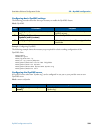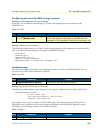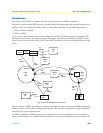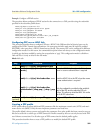
PPP configuration task list 315
SmartWare Software Configuration Guide 30 • PPP configuration
its own IP interface. In addition to these PPPoE sessions, pure IP traffic can run concurrently over the same
Ethernet port. This is achieved by binding the Ethernet port directly to an IP interface.
PPP configuration task list
To configure PPP, perform the following tasks:
• Creating an IP interface for PPP
• Configuring for IP address auto-configuration from PPP (see page 317)
• Creating a PPP subscriber (for authentication) (see page 317)
• Configuring a PPPoE session (see page 319)
• Configuring PPP over a HDLC Link
• Creating a PPP interface within the CS context (not currently available)
• Creating a PSTN interface for PPP dial-in/dial-out (not currently available)
• Creating a PPP profile (see page 321)
• Displaying PPP configuration information (see page 324)
• Debugging PPP (see page 325)
Creating an IP interface for PPP
An IP interface is required to link a PPP connection to the IP context. The IP interface must apply a network
address port translation (NAPT) if the PPP service provider only offers a single IP address and not an IP sub-
net, or if the IP addresses on the LAN shall be private and hidden behind a public IP address (see 11, “NAT/
NAPT configuration” on page 132 for more information about NAPT).
This procedure describes how to create an IP interface for PPP
Mode: Context IP
Step Command Purpose
1 node(ctx-ip)[router]#interface name Creates the new interface name, which repre-
sents an IP interface.
2 node(if-ip)[name]#point-to-point Only defines what route is entered into the IP
routing table:
• point-to-point: A route to the IP address of
the PPP interface (assigned by the PPP peer)
is entered into the routing table.
• no point-to-point: A route to the subnet
defined by IP address of the PPP interface
(assigned by the PPP peer) is entered into
the routing table. The class of the IP address
determines the size of the subset.
Recommendation: Use ‘point-to-point’ and spec-
ify a default route.


















